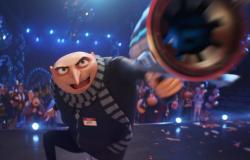Jean-Luc Godard said that the face of Jerry Lewis It was the intersection where artifice elevated to its maximum power and all the potential of the best documentaries met. I don’t know what he meant by that, although I’ve done my math and I assume he was referring to the fact that a comedian, to be truly important, must make us laugh but must also do “other things.” Let’s say then that laughter and artifice raised to maximum power go together, and that documentaries and the ability of great comedians to do “other things” in addition to making us laugh also go together. The remaining question would be what those “other things” are.. Maybe make us see or understand something hidden behind his jokes and grimaces? Glimpse drama or tragedy from comedy? Realize the seriousness of humor? Perhaps remember the magic words of Thomas Pynchon when he said: “have fun but don’t get lost”?
Charles Chaplin decided to kill Charlot in a heroic way, giving him the voice he had not had until The great Dictator (The Great Dictator, 1940) and then confronting him with Adolf Hitler, to whom the film was directed with that conviction that artists sometimes have if they confront Evil using their harmless works. His defeat during the Second World War, which he was not able to stop, has not prevented him from winning the battle, at least in the history of cinema, where he increased the moral scope of his work and Even today he reminds us with his moving final speech that there are voices whose echo never dissipates nor is prescribed. not because they appeal to an indisputable truth but because they appeal to the indisputable right to denounce horror, no matter how clumsy or sentimental we may seem while rebelling against those who perpetrate it.
“Like Charles Chaplin, Buster Keaton or Jacques Tati, Jerry Lewis was an architect of images, as if he were at the same time a choreographer and a filmmaker, surely that is why there are very few of his films in which he is not seen dancing.“
Jerry Lewis learned a lot from Charlot, among other things to enhance the possibilities of his body and to be uninterested in his dialectical possibilities, always kept very close to the babbling of small children. If Charlot was always a silent film character, even in City Lights (City Lights1931) and Modern times (Modern Times1936), Jerry Lewis can also be considered a silent film comedian, in his case because he did not allow, since he had some control over the films in which he participated and in which he later directed himself, that words had more prominence than the images. If he had to speak, it was to talk nonsense; If she had to sing, it was to do it out of tune.. Of course, he used to ensure that none of these things went unnoticed, because he did not conceive of a single shot, from a certain moment on, in which the staging would slide by without attracting attention. Like Charles Chaplin, Buster Keaton or Jacques Tati, Jerry Lewis was an architect of images, as if he were at the same time a choreographer and a filmmaker, surely that is why there are very few of his films in which he is not seen dancing. There is no shortage of those who associate him with Elvis Presley and with the Rock And Rollassuming that Jerry Lewis’s gestural and corporal revolution was a precedent for the king. Both gave the young generations of the fifties their new impulses, synthesized in “sex, drugs and Rock And Roll». They turned, so to speak, the body into a weapon of mass destruction, with enough impact not to need the support of their words. It was, however, what the young people of the time needed, to whom Jerry Lewis’ films as a couple and alone, and even later those of Elvis Presley, were mainly directed.
Of all the comedians in the history of cinema, perhaps Jerry Lewis is one of the most radical. By radical, I mean difficult to synthesize, rationalize or tame in any sense. That would explain, to a certain extent, the hatred and love that his work still generates today. While the Americans condemn his egocentrism (and never awarded his film work, they only gave him an honorary Oscar for his humanitarian work) and the vulgarity of the characters he played, the French call him a poet and praise his most belligerent side. of his jokes. Americans hate him because he stands out and the French love him because he stands out. The former dislike his desire for prominence and the latter marvel at his ability to take center stage. Both have their share of truth. However, it is striking that Jerry Lewis’ wild and provocative humor has more followers outside his country, as if he could only be accepted from a distance, without fully understanding him. In his country, however, they never looked favorably on his progressive zeal for control in his films, which he began by acting and very soon began writing and directing himself, as if no one else was capable of visualizing his ideas or doing them with its same precision.
The truth is that in the United States they have never liked comedians who try to be too smart and neither have those who try to be too stupid; There, in terms of humor, middle ground has always been appreciated. This is why comedians who are too radical end their careers prematurely or are rejected from the beginning. Jerry Lewis, for example, fell out of favor from the moment he began to take things very seriously., trying to make his films reflect the most absurd and harmful aspects of American society: the banality of the middle class, the consumerist fever, the fear caused by sex or the growing television addiction. They never forgave him for taking himself too seriously, much less for wanting to make films with a message, to the extent that Charles Chaplin had done previously. His biggest frustration was the unfinished film The day the clown laughed (The Day the Clown Cried, 1972), about the Jewish Holocaust. It was never completed nor released, although the Library of Congress has a copy donated by Lewis himself before his death, so that it is available to future researchers. Apparently, the project failed first due to lack of financing and secondly, when Lewis decided to invest his own money, due to the comedian and filmmaker, who made changes to the script and turned the character he himself played into such an abject being. as unbearable: He was a comedian with no luck or career, incapable of entertaining anyone, who only managed to make Jewish children laugh shortly before they were killed in the gas chambers..


In the United States there are many examples of comedians who were censored or marginalized from the beginning of their careers. Only in the world of cinema, a few decades ago they were Andy Kaufmann, Lenny Bruce or Elaine May; and right now they are Albert Brooks, Joe Dante and even Woody Allen, who is appreciated more in Europe than in his own country. They all commit the same sin: questioning identity and doing so by cultivating their own in a disproportionate and unprejudiced way. They want to make us see how complicated it is to distinguish between adults and children, between stupid and smart, between handsome and ugly… They also claim their ego and declare their rebellion against those who try to crush their individualism. For many of them, cultivating their sense of humor is the only way to increase their self-esteem; Without laughing at themselves and others, it is impossible for them to accept themselves. How can we not do it in a country where Donald Trump has just become president and the people and the justice system seem to have to laugh at all his abuses, crimes and incitements to sedition, jokes all of which are very unfunny? The problem, in the case of real comedians, is that sometimes they go too far and are not usually millionaires, like Trump.
“Producers do not like to deal with people with such enormous egos as comedians, who believe they are capable of transforming and controlling reality at their whim.“
Jerry Lewis, in that sense, ended his career in a bad way, with almost no funding to direct. Hit it hard, Jerry! (Hard Working1980) and Jerry’s crazy world (Cracking Up1983), a bit like what happened to Jacques Tati with Zafarrancho in the circus (For the, 1974). It is the price that every comedian must pay when he becomes too meticulous and creates gags that dismantle reality, turning it upside down. Unfortunately, people are afraid of losing their few possessions, their few certainties, their weak security.. And producers do not like to deal with people with such enormous egos as comedians, who believe they are capable of transforming and controlling reality at their whim; They believe, in fact, they are smarter than anyone else.


Although Jerry Lewis’s first years in show business were not exactly easy, as he had to stumble around seedy theaters and nightclubs, when he found Dean Martin his luck changed. Together they formed one of the most successful couples in the history of cinema, although their films were almost always so uninspired that, except Artists and models (Artists and Models, 1955, Frank Tashlin), are no longer remembered. Dean Martin, however, was hardly interested in the quality of the cinema in which he participated as long as he was paid; but Jerry Lewis was too perfectionist and ambitious to settle for success. Hence the two clashed, finally separating after many filmings plagued by the tensions between them. In the sixties Jerry Lewis did his most important works, directed by himself or by Frank Tashlinone of the few filmmakers who knew how to bring out the best qualities of the comedian, especially in I am the father and the mother (Rock-a-Bye Baby1958), The Ashen (Cinderella, 1960) and Clinical case in the clinic (The Disorderly Orderly1964), a film where the hand of the student was more noticeable than that of the teacher, the talent of the actor was more noticeable than that of the director.
“This shot/reverse shot methodology was also applied by Jerry Lewis when he presented himself in his films as an individual with a dual personality.“
Comedians usually strive to build a formal universe in each of their films, then enter it and, with their mischief, wreak havoc. If Jacques Tati preferred to stage, Jerry Lewis preferred to contrast. The French comedian had a film conception inherited from silent cinema; and the American comedian, who began developing strategies typical of silent film comedians (especially Charles Chaplin and Buster Keaton), ended up working with primarily television records, in which his body became part of the message, wrapped in a world of objects and colors typical of consumer capitalism, but not the only message (as at the beginning of his career, when thanks to the athletic contortions of his body and his loud babbling he could be considered something like a liberator of youth).
To a good part of the gags proposed by Jerry Lewis in his best films, I would classify them as reverse shot humor., because his film approaches are based on contrasting someone’s attitude with the effect it produces on the comedian’s body. This shot/reverse shot methodology was also applied by Jerry Lewis when he presented himself in his films as an individual with a dual personality, capable of having adult and childlike attitudes, secure and insecure, shy and extroverted… The crazy professor (The Nutty Professor1963) can be considered, with respect to the above, his most important work, a rereading of The Strange Case of Dr. Jekyll and Mr. Hyde which is both tragic and comic, and in which it is made very clear that we almost never manage to be who we really are, not even who we want to be, but rather an amalgamation of what others want us to be and of what society turns us into.


0/5
(0 Ratings. Rate this article, please)










